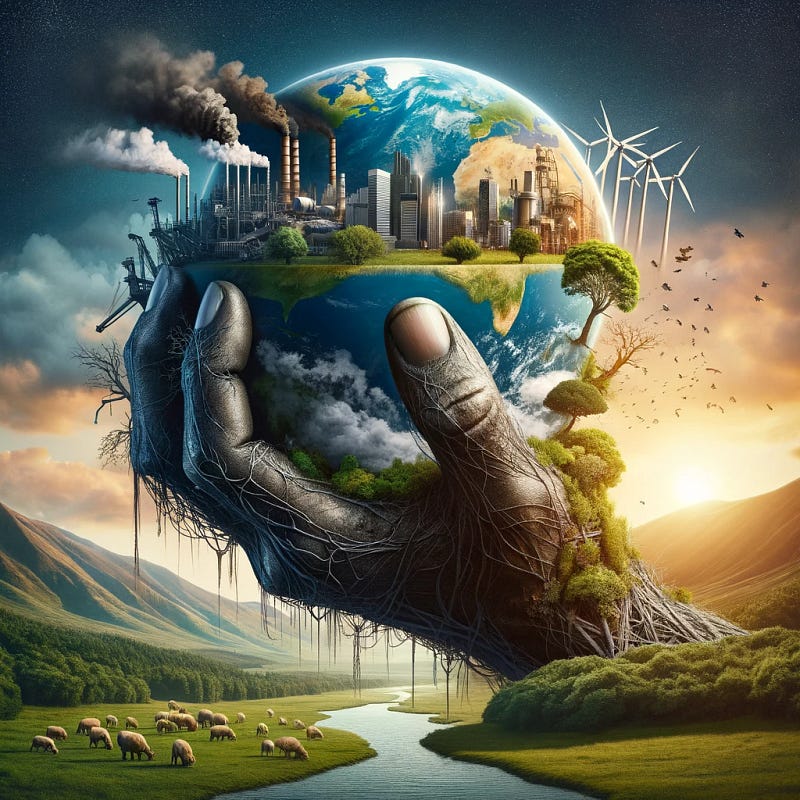How Capitalism’s Emphasis on Growth Will Destroy the Planet (and How to Stop It)
Part One: Introduction to Capitalism and Sustainability

This article is part of a series exploring capitalism and sustainability. Make sure to follow my blog and subscribe to get email updates so you never miss any of my work!
Capitalism has many possible definitions and modes of behavior. It is not simply an economic system, but a philosophical one. We know that capitalism has functioned in small ways throughout much of human history (Harris & Delanty, 2023, p. 339). However, it is only within modernity that its marriage to mercantilism, debt, and bureaucratic power have given rise to the consolidated hydra underpinning our assumptions of the world.
In their article “What is capitalism? Toward a working definition,” Neal Harris and Gerard Delanty arrive at a complex definition of capitalism based on its historical and modern contexts, and the way that it interacts with sectors of knowledge and behavior well outside the merely economic.
In short, they suggest that capitalism be defined as an economic system characterized by private ownership of production means, where free markets, competitive enterprise, and the pursuit of profit drive the production and distribution of goods and services, supported by wage labor, property rights, financial mechanisms, state regulation, and a continuous growth through reinvestment of profits.
Try saying that three times fast.
It breaks down into seven primary categories:
- Free enterprise and the competitive market.
- The pursuit of profit and its private appropriation.
- Wage labor and the production of commodities.
- Property rights.
- The financial infrastructure of money and investment that facilitates credit and debt.
- A highly variable degree of state regulation.
- A propensity for growth through the productive re-investment of profit.
Though none of these is, itself, a simple matter to describe. For instance, let us explore Karl Marx’s theory of surplus value, which highlights a glaring danger utterly inherent to capitalist economic structures: “M-C-M.”
This equation refers to the flow of money within a capitalist system.
- “M” is the money being invested by the capitalist, the owner of capital.
- “C” refers to the commodities that “M” is used to purchase. Note that “commodities” in this sense means everything purchasable including goods and data, but most importantly any forms of labor involved in the process.
- The final “M” is the return on profit to the capitalist, gotten about by undervaluing the labor of those employed within the system.
By undervaluing labor, the capitalist can ensure that they will get a larger return on their investment.
This process also leads to a system of perpetual growth an extraction, where ever greater lengths must be explored in search of increasingly narrow profits. The capitalist must find new and unique ways of squeezing out wealth from the laborer, or they must expand into new territories that have not yet been plumbed in order to see a larger return.
This creates capitalism’s inherent sustainability problem.
“In an increasingly globalized economic system, the capitalist drive for profit making and economic expansion results in a perpetual treadmill of production and consumption heavily reliant on fossil fuels and other substances that produce greenhouse gas emissions” (Baer, 2021, p. 3).
Sustainability is another longstanding concept woven through history. The Iroquois Confederacy maintained this concept within their Great Law of Peace, which stated that “chiefs consider the impact of their decisions on the seventh generation to come” (Heinberg & Lerch, 2010, p. 1).
Effectively, sustainable thinking is that which considers the actions of the present against possible and likely effects in the future, and attempts to mitigate damage to the living network. It is a holistic attitude rather than a reductionist one, and it is diametrically opposed to capitalism’s fundamental tenets of unilateral growth.
Tom Kuhlman and John Farrington attempt to explore the concept of sustainability in a 2010 paper where they highlight that “separating the needs of the present from the needs of those who will come after us” is a good way of understanding the concept, with the former being considered as “well-being and the latter sustainability” (Kuhlman and Farrington, 2010, p. 3444).
Richard Heinber, a renowned climate scientist and author, went a little further. He outlined several axioms (self-evident, scientifically testable, truths) with which to define the concept of sustainability.
This is the first of them:
- Any society that continues to use critical resources
unsustainably will collapse. - Exception: A society can avoid collapse by finding
replacement resources. - Limit to the exception: In a finite world, the number
of possible replacements is also finite.
(Heinberg & Lerch, 2010, p. 3)
Wrapping things up (until next time)
As we unravel the intricacies of capitalism and its clash with sustainability, it becomes evident that our current trajectory threatens the very fabric of our planet. One cannot extract unlimited material from a limited space. Or, to use capitalism’s favorite metaphor of growth: one cannot grow limitlessly within a limited environment without destroying that environment.
Understanding capitalism’s mechanisms — its relentless pursuit of growth at the expense of equitable labor valuation and environmental stewardship — sheds light on the paths we might take to avert this crisis.
Our exploration doesn’t end here.
In the next article in this series, I’ll delve deeper into innovative solutions being employed even now on the capitalist stage, and show how even proponents of capitalism are starting to understand that short-term gains always lead to long-term losses in the end.
References
Baer, H. A. (2021). Global capitalism and climate change: The need for an alternative world system (Second Edition). Lexington Books.
Harris, N., & Delanty, G. (2023). What is capitalism? Toward a working definition. Social Science Information, 62(3), 323–344. https://doi.org/10.1177/05390184231203878
Heinberg, R., & Lerch, D. (Eds.). (2010). The post carbon reader: Managing the 21st century’s sustainability crises. Watershed Media ; Post Carbon Institute ; Distributed by the University of California Press.
Kuhlman, T., & Farrington, J. (2010). What is Sustainability? Sustainability, 2(11), 3436–3448. https://doi.org/10.3390/su2113436
